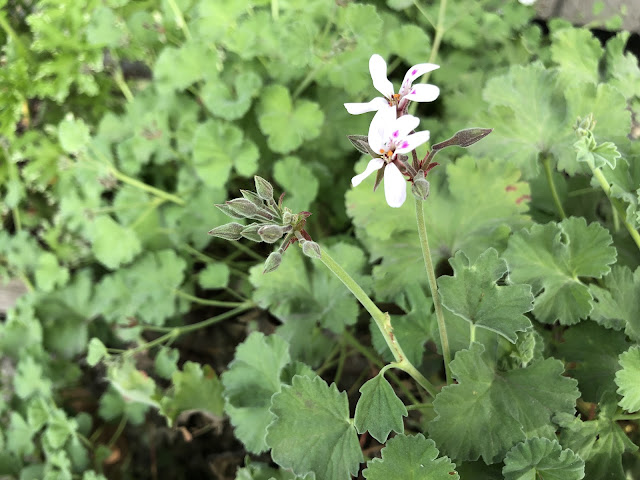
Rain may finally be headed Sacramento's way; more 70-degree days in forecast

|
|
Pelargoniums are excellent perennial "understory" plants or ground cover. The flowers are small but beautiful; many are just blooming now. (Photo: Kathy Morrison)
|
Sacramento’s historic winter dry spell may finally be coming to an end.
According to the National Weather Service, “likely rain showers” are in Sacramento’s forecast for late Monday night and most of Tuesday. Downtown Sacramento’s last measurable rain – 0.05 inches – fell Jan. 7. A slight chance of showers is also in Sunday’s early morning forecast.
But it won’t be much; the Monday-Tuesday storm is expected to drop up to 0.30 inches on Sacramento. At least, it’s something. During normal rain years, March averages 2.75 inches.
After this brief wet interlude, Sacramento will see more mild sunny days in the low 70s, but nights will still be chilly, averaging in the mid 40s. Wait a little longer on setting out tomatoes and peppers.
During this warm spring weather, show your hard-working garden some TLC.
* Seed and renovate lawn and grasses. Feed cool-season grasses such as bent, blue, rye and fescue with a slow-release fertilizer. Check the irrigation system and perform maintenance. Make sure sprinkler heads are turned toward the lawn, not the sidewalk.
* Fertilize roses, annual flowers and berries as spring growth begins to appear.
* If aphids are attracted to new growth, knock them off with a strong spray of water or insecticidal soap. To make your own “bug soap,” use 2 tablespoons liquid soap – not detergent – to 1 quart water in a spray bottle. Shake it up before use. Among the liquid soaps that seem most effective are Dr. Bronner’s Pure-Castile Soaps; try the peppermint scent.
* Pull weeds now! Don’t let them get started. Take a hoe and whack them as soon as they sprout.
* Prepare vegetable beds. Spade in compost and other amendments.
* Prune and fertilize spring-flowering shrubs after bloom.
* In the vegetable garden, transplant lettuce, collards and kale.
* Seed chard and beets directly into the ground. (Beet seeds benefit from soaking first.)
* Plant summer bulbs, including gladiolus, tuberous begonias and callas. Also plant dahlia tubers.
* Transplant perennials.
Comments
0 comments have been posted.Sacramento Digs Gardening to your inbox.
Sites We Like
Garden Checklist for week of April 21
This week there’s plenty to keep gardeners busy. With no rain in the immediate forecast, remember to irrigate any new transplants.
* Weed, weed, weed! Get them before they flower and go to seed.
* April is the last chance to plant citrus trees such as dwarf orange, lemon and kumquat. These trees also look good in landscaping and provide fresh fruit in winter.
* Smell orange blossoms? Feed citrus trees with a low dose of balanced fertilizer (such as 10-10-10) during bloom to help set fruit. Keep an eye out for ants.
* Apply slow-release fertilizer to the lawn.
* Thoroughly clean debris from the bottom of outdoor ponds or fountains.
* Spring brings a flush of rapid growth, and that means your garden is really hungry. Feed shrubs and trees with a slow-release fertilizer. Or mulch with a 1-inch layer of compost.
* Azaleas and camellias looking a little yellow? If leaves are turning yellow between the veins, give them a boost with chelated iron.
* Trim dead flowers but not leaves from spring-flowering bulbs such as daffodils and tulips. Those leaves gather energy to create next year's flowers. Also, give the bulbs a fertilizer boost after bloom.
* Pinch chrysanthemums back to 12 inches for fall flowers. Cut old stems to the ground.
* Mulch around plants to conserve moisture and control weeds.
* From seed, plant beans, beets, cantaloupes, carrots, corn, cucumbers, melons, radishes and squash.
* Plant onion sets.
* In the flower garden, plant seeds for asters, cosmos, celosia, marigolds, salvia, sunflowers and zinnias.
* Transplant petunias, zinnias, geraniums and other summer bloomers.
* Plant perennials and dahlia tubers for summer bloom.
* Mid to late April is about the last chance to plant summer bulbs, such as gladiolus and tuberous begonias.
* Transplant lettuce seedlings. Choose varieties that mature quickly such as loose leaf.